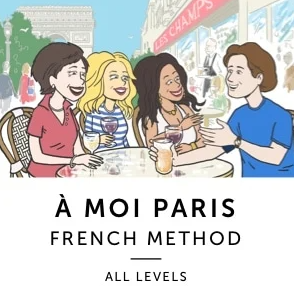French present participle and gerund
The French present participle (participe présent) is formed by dropping the -ons on the nous form of the verb in the present tense and adding -ant. This is the equivalent of the -ing ending in English. For example, nous parlons -> parl -> parlant (speaking). The gerund (le gérundif) is formed by preceding the present participle with “en”. For example, “en parlant” (while speaking).

How to form the French present participle
The present participle is always formed by removing the -ons in the nous form of the present tense an adding -ant. Present participles can be nouns, adjectives and verbs.
The verbs être (to be), avoir (to have) and savoir (to know) have irregular present participle forms.
The following table shows how to form the present participle in French.
| PARLER TO SPEAK | |||
| nous parlons | we speak | parlant | speaking |
| SORTIR TO GO OUT | |||
| nous sortons | we go out | sortant | going out |
| FINIR TO FINISH | |||
| nous finissons | we finish | finissant | finishing |
| CROIRE TO BELIEVE | |||
| nous croyons | we believe | croyant | believing |
| VENDRE TO SELL | |||
| nous vendons | we sell | vendant | selling |
| -CER AND -GER VERBS -> USE Ç AND AN EXTRA E | |||
| MANGER TO EAT | |||
| nous mangeons | we eat | mangeant | eating |
| LANCER TO THROW | |||
| nous lançons | we throw | lançant | throwing |
| REFLEXIVE VERBS FOLLOW THE SAME PATTERN | |||
| se balader | to have a walk | se baladant | walking |
| se souvenir | to remember | se souvenant | remembering |
| ÊTRE, AVOIR AND SAVOIR ARE ALL IRREGULAR | |||
| être | to be | étant | being |
| avoir | to have | ayant | having |
| savoir | to know | sachant | knowing |

French present participle examples of nouns and adjectives
Nouns
When using the present participle to form a noun, add an -e for the feminine form and -s for the plural form.
- le gagnant the winner (m) la gagnante the winner (f)
- le perdant the loser (m) la perdante the loser (f)
Adjectives
When used as an adjective, the present participle must agree in gender and number with the noun it modifies.
- un travail exigeant A demanding job
- un enfant fatigant A tiring child
- un film amusant A fun movie
- un voyage épuisant A tiring trip
- un roman fascinant A fascinating novel
Verbs
The present participle may also be used to equate to the English -ing ending.
- Je t’ai vu entrant dans la maision. I saw you entering the house.
- Ayant moins de temps libre, j’ai décidé d’annuler mes vacances. Having less time, I decided to cancel my vacation.
- Ne sachant pas sa réponse, je ne savais pas quoi faire. Not knowing her answer, I didn’t know what to do.
To express “having + verb+ed” (for example, “having worked”) combine the auxiliary verb avoir or être with the past participle.
For example: Ayant mangé (having eaten) and étant retourné (having returned).
- Ayant payé mon loyer, je n’avais plus d’argent. Having paid my rent, I didn’t have any more money.
- Étant arrivé en retard, j’ai raté la réunion. Having arrive late, I missed the meeting.
- Étant parti de bonne heure, nous sommes arrivés en avance. Having left early, we arrived ahead of time.
How to use the French gerund
The French gerund is formed by combining en with the present participle. The present participle is formed by replacing the –ons in the nous present form with –ant.
The gerund can be used to express simultaneous actions (while + verb in -ing form) as well as cause and effect actions (by verb in -ing form).

Example sentences using the gerund
When used to form sentences, the gerund (en + present participle) can translate to both “by verb+ -ing form” and “while verb + -ing form”. For example, en mangeant translates to both “by eating” and “while eating”.
- J’apprends le français en écoutant des podcasts. I learn French by listening to podcasts.
- Tu apprends l’espagnol en passant tes vacances en Espagne. You learn Spanish by/while spending your vacation in Spain.
- Il s’est cassé une dent en mangeant une glaçon. He broke a tooth while eating an ice cube.
- Elle s’est perdue en se baladant dans le désert. She got lost walking in the desert.
Tout + gerund structure
The structure “tout + en + gerund” is used to express a contradiction between two occurances.
- Tout en étant très travaileur, il n’atteignait pas ses objectifs. Even though he was hardworking, he wasn’t reaching his goals.
- Tout en ne disant rien, il disait tout. While saying nothing, he was saying everything.
Related Lessons:
- Most commonly used French verbs
- Guide to French verb tenses
- Guide to the French future tense
- How to use the French conditional tense
- Passé composé vs. imperfect tenses explained
- French subjunctive mood explained



